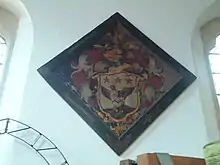Sir Thomas Spring, 3rd Baronet
Sir Thomas Spring, 3rd Baronet (c. 1672 – 2 April 1704) of Pakenham Hall in Pakenham, Suffolk, was an English baronet and landowner[2] who served as High Sheriff of Suffolk in 1696.[3]


Career
Spring was the eldest son of Sir William Spring, 2nd Baronet and Sarah Cordell, daughter of Sir Robert Cordell, 1st Baronet of Melford Hall, Suffolk.[4][5] He was educated at Christ's College, Cambridge and inherited his father's title and estate upon his death in 1684.[6]
Marriage and issue
On 23 May 1691, he married Hon. Merolina Jermyn, a daughter and co-heiress of Thomas Jermyn, 2nd Baron Jermyn and Mary Merry, and co-heiress of Henry Jermyn, 1st Baron Dover.[7] They had three sons and six daughters:[8]
- Thomas Spring (died 1694)
- Merolina Spring (died 1694)
- Merolina Spring (1695–1761), married Thomas Discipline of Bury St Edmunds.[9] She inherited the manor of Packenham,[10] in the church of which survives the funeral hatchment of Thomas Discipline, showing his arms with inescutcheon of Spring.
- Sir William Spring, 4th Baronet (1697–1736), died unmarried. He bequeathed his estates to his two surviving sisters, Merolina and Mary,[11] but was succeeded in the baronetcy by his uncle Sir John Spring, 5th Baronet (1674–1740).[12]
- Mary Spring (1698–1765), married Revd. John Symonds and was the mother of John Symonds and Thomas Symonds and grandmother of Admiral Sir William Symonds[13]
- Penelope Spring (1700–1707)
- Jermyn Spring (died aged 17)
- Henrietta Maria Spring (died January 1733), died unmarried
- Delariviera Spring (died 1 February 1733), died unmarried
Death and succession
Sir Thomas Spring was buried on 6 April 1704 in Pakenham parish church.[14] He was succeeded in his title by his only surviving son, Sir William Spring, 4th Baronet (1697–1736),[15] who died unmarried, when the baronetcy, but not his estates, passed to his uncle Sir John Spring, 5th Baronet (1674–1740).
References
- Discipline: Argent, on a mount vert a falcon rising proper belled or in chief three mullets gules (Arms granted to "DISCIPLINE of Bury" on 23 June 1731, per Davy . Misc . Gen. 4th. S. II, I 16). (Source: Corder, Joan, Dictionary of Suffolk Arms, Vol.VII, Suffolk Records Society, 1965, p.125
- Arthur Collins, 'Spring, of Pakenham', The English Baronetage (Volume 2, Tho. Wotton, 1741), p.243.
- Arthur Collins, 'Spring, of Pakenham', The English Baronetage (Volume 2, Tho. Wotton, 1741), p.243.
- William John Courthope, Synopsis of the Extinct Baronetage of England (Rivington, 1835), p.187.
- ThePeerage.com (entry #455799) http://www.thepeerage.com/p45580.htm (Accessed 11 February 2015)
- Arthur Collins, 'Spring, of Pakenham', The English Baronetage (Volume 2, Tho. Wotton, 1741), p.243.
- William Harvey, The Visitation of Suffolke (Volume 2, S. Tymms, 1868), p.185.
- Arthur Collins, 'Spring, of Pakenham', The English Baronetage (Volume 2, Tho. Wotton, 1741), p.243.
- The English Baronetage:: Containing a Genealogical and Historical Account of ... By Thomas Wotton, Vol II, London, 1741, p.243
- "Pakenham-Village of Two Mills : PV book - Chapter 7 - the Manors of Pakenham".
- "Pakenham-Village of Two Mills : PV book - Chapter 7 - the Manors of Pakenham".
- The English Baronetage:: Containing a Genealogical and Historical Account of ... By Thomas Wotton, Vol II, London, 1741, p.243
- Symonds, Sir William; Sharp, James A. (1858). Memoirs of the Life and Services of Rear-Admiral Sir William Symonds: Surveyor of the Navy from 1832 to 1847. Longman, Brown, Green, Longmans, & Roberts. pp. 2–4. Retrieved 14 February 2019.
- Joseph Jackson Howard, ‘Spring’, The Visitation of Suffolk ( Whittaker and Co, 1866), pp.165-206.
- William John Courthope, Synopsis of the Extinct Baronetage of England (Rivington, 1835), p.187.